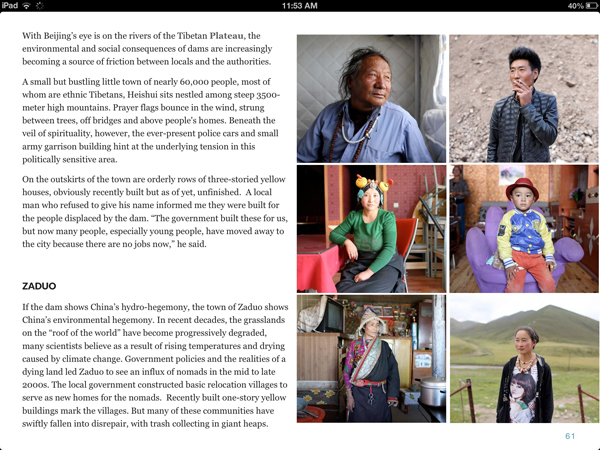Hollowed-out trunk of a strangler fig (photo)
This is a view from the base of a strangler fig in Xishuangbanna Tropical Botanical Garden, Yunnan, China. The tree that once served as the support for this strangler has long since rotted away, leaving only the roots of the fig.
Reporter’s Journal: A story sans words
Special Reporting Initiatives photographer Dominic Bracco II tries to capture the aquaculture scene at Liangzi Lake. A local fishfarmer attempts to capture his own view. Dominic’s photos will appear with Erik Vance’s reporting on the demand for sustainable fisheries products in China.
Reporter’s Journal: It isn’t a beluga
Special Reporting Initiatives Fellow Erik Vance gets up close and personal with a finless porpoise housed at Institute of Hydrobiology in Wuhan, China. Vance and his colleague, photographer Dominic Bracco II, are reporting on the market for sustainable fisheries in China. Photo credit: Shouqi...
Change on the roof of the world: new book explores climate change and the Tibetan Plateau
Excerpt from the new book Meltdown: China’s Environmental Crisis by Sean Gallagher Adapted By Caroline D’Angelo With soaring mountains and vast grasslands, the Tibetan Plateau covers approximately one quarter of China. The plateau’s glaciers hold the largest store of freshwater on earth outside the North and South Poles. Though remote and sparsely populated, the plateau is of crucial importance to China and its downstream...
Sea Turtles Released During Earth Hour
Written by Jemma Smith To commemorate this years Earth Hour and raise awareness of turtle conservation, the Chinese organization Sea Turtles 911 released two Green Sea Turtles (Chelonia mydas) back into the wild during this special hour. Earth Hour encourages businesses and households worldwide to switch off their lights for one hour between 8.30pm and 9.30pm on the 23rd of March. This is to raise awareness of climate change. This...
Eats, shoots and leaves, an essay on giant pandas
Giant panda in Chengdu in South Western China. Photo by: Shubhobroto Ghosh. By: Shubhobroto Ghosh Please note : The opinions expressed in this article are those of the author and not representative of the viewpoints of any organization. “We have to remember that what we observe is not nature herself, but nature exposed to our method of questioning” – Werner Heisenberg, Nobel Prize winner in Physics (1932) in Physics...
Will food dominate 21 century geopolitics? (radio)
One billion people in the world are going hungry–more than any other time in history. Yet food security remains a pretty low concern in most industrialized countries. That may not last long according to renowned environmentalist, Lestor Brown, who says that climate change, population growth, rising consumption of meat and dairy, and water issues could soon make food a flashpoint worldwide. Already, high food prices this year...
Photo: world’s most threatened forest
Forest along the Nam Ou river in Laos. Photo by Rhett A. Butler Deforestation for a rubber plantation in Laos. Photo by Rhett A. Butler Yesterday, Conservation International (CI) released a top 10 list of the world’s most threatened biodiverse forest. Number one were the forests of Indo-Burma, including Laos, Thailand, Vietnam, Cambodia, Myanmar (Burma), and parts of China and India. This landscape includes the forests in Laos...
The view from the air
Angel Falls in Venezuela. Photo by Rhett A. Butler River in the lowlands of Gabon. Photo by Rhett A. Butler. Rice fields in Madagascar. Photo by Rhett A. Butler. Mountains in Western China. Photo by Rhett A. Butler. Flowering trees in the Peruvian Amazon. Photo by Rhett A. Butler. African buffalo in the Okavango Delta, Botswana. Photo by Jeremy...
Camel and government-built yurts
A camel stands in front of government-built yurts near Lake Karakul in the Xinjiang Province of north-western China. Photo by: Rhett A. Butler . Click to see more photos from Lake...
Silk Road mountains
Mountains rise in Xinjiang, the Silk Road region of western China. Photo by Rhett A. Butler. To see more photos of China.
The First World Consumption Factor
In a New York Times editorial published January 2, Jared Diamond examines the large discrepancy between consumption in first world countries versus developing countries: citizens of the rich world consume an average of 32 times the resources as those in poor countries. The estimated one billion people who live in developed countries have a relative per capita consumption rate of 32. Most of the world’s other 5.5 billion people...






